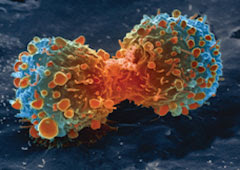|
| ||
1. Trends in the number of cancer cases: a global increase, but deaths are in decline.
As populations get older, and age is one of the main cancer risk factors, the number of cases is, on the whole, increasing. However, thanks to earlier detection and more effective treatments, mortality is decreasing, at least for some types of cancer like breast cancer.
2. Main causes of cancer: infections, lifestyle and environment rather than heredity. As WHO point out, the proportion of cancers caused directly by hereditary genetic factors is small. The role played by genes are multiple, and if some affect directly the disease, other are known to increase the risk of developing cancer. The increase in the number of cases is mainly due to other factors like the exposure to infectious agents or lifestyle factors: inactivity, poor diet, use of alcohol, tobacco, obesity. About 20% of all cancers could be attributable to environmental factors: air pollution, UV exposure, indoor smoke due to solid fuels and exposure to radon.
3. How does cancer develop?
The transformation of a normal cell in a cancerous cell is a multi-stage process. It is not because a substance is classified as "carcinogenous" that exposure to it will necessarily cause cancer. Many factors enter into actual risk, including the duration of exposure and the individual's genetic context. Studies looking at large groups of people and that compare various risk factors (lifestyle, professional activity, ...) cannot easily directly prove that a particular behaviour or a particular substance case cancer, and that can lead to false perception of causes of cancer and the effect of some of these risk factors.
4. How can cancer be prevented?
Primary prevention aims at avoiding dangerous behaviors or exposures, and secondary prevention aims at early detection of cancer.
For more information and in-depth details, read our online summary
. | |||
最受歡迎 30天 | Most Popular 30 days
-
女兒弒母悲劇/家屬擔子重 援手又在何方 | http://goo.gl/t7JEeH 女兒弒母悲劇/長照不加強 悲劇會再重演 http://goo.gl/JSRmiR 手刃病榻愛妻 照護者悲歌 | http://udn.com/NEWS/OPINION/X1/8945411.s...
-
Information and Knowledge Management for Climate Change (IKM4CC) Guidelines: complete set http://www.pacificclimatechange.net/document/in...
-
Social Psychology of Public Response to Nuclear Power Policy Social Psychology ...
Monday, January 9, 2017
Level 1 Cancer rates and mortality, types and causes: a synthesis urle.me/PE
Subscribe to:
Post Comments (Atom)

No comments:
Post a Comment